Tank Tiers
Tier 0
Starting Tier
French
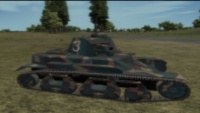
| |
| R-35 |
R-35: (mostly used against infantry or in support of infantry because its gun is lousy against tanks).
Good armour for fending off any ranged attack from German 37mm ATG's, can be defeated by German guns like the PzKw.IVd and StuG.IIIb rather easily.
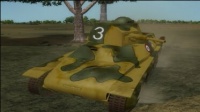
| |
| H-39 |
H-39: (considered the n00b anti-tank tank in French ranks since it's gun is better than the R-35).
Armour similar to R-35, perhaps slightly inferior if caught red-handed by the lighter 37mm ATG's.
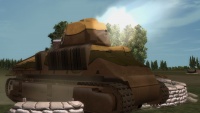
| |
| S-35 |
S-35: The go-to tank in tier 0. Reasonable armour, good gun for 1940. Not as slow as the other French tanks.
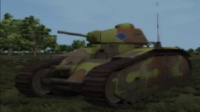
| |
| Char.B1-bis |
Char.B1-bis: The slow behemoth. Turret gun similar to S-35 but TONS more armour. Slow like 3 toed sloth on Thanksgiving afternoon.
The hull 75mm howitzer can kill tanks but it's a bit like playing pool blindfolded due to the rainbow trajectory, and you must turn the entire tank to traverse the gun. Only expert heavy tankers can be effective in this tank but when they do, it can really turn a battle.
Great infantry support tank if you get a large infantry attack underway.
British
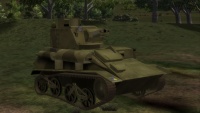
| |
| Vickers Mk.V |
Vickers Mk.V: A scout tank. Cannot hope to survive combat against ANY German tank. Main gun is a Vickers 12.7mm Heavy Machine Gun.
Not as hard hitting as the American .5" Browning ... it wouldn't normally even beat a German scout car because while it would be able to penetrate it, the scout car's 20mm cannon would chew up the Vickers tankette with much heavier AP rounds.
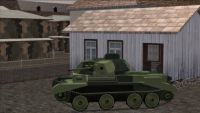
| |
| A-13 |
A-13: Typical of the British approach in the early war, this tanks trades armour for speed. The QF 2pdr. gun was a good AT gun in 1940, but lacks a high explosive round, making it a pure AT platform.
Everything that sees you in an A-13 is going to try and penetrate you, and a bunch of those that try are going to succeed. A-13 drivers need to have the element of surprise and then quickly relocate elsewhere to do well. It's an ambush tank.
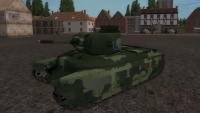
| |
| Matilda Mk.II |
Matilda Mk.II: The German tankers worst nightmare in 1940. While the armour can be defeated at point blank range from perpendicular angles (90 degree perfect impacts) to the sides and rear, a lot of the time the sheer overall thickness from most available approaches and range, will just frustrate them. Only after the 50mm AT gun becomes available does the Matilda become more vulnerable in combat. Luckily for the Germans the British have far less Matilda's available to them than the Germans have 88mm FlaK guns, which can kill Matilida's at long ranges. German tier 0 tanks should avoid Matilda's as often as possible.
German
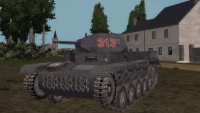
| |
| PzKw.IIc |
PzKw.IIc: A light tank which functions as a scout tank. Much slower then the British Vickers scout tank, it is however much better armoured, with a heavier gun to boot. Not to be used against other tanks in combat, with the exception beating the Vickers it won't win any tank fights, ever.
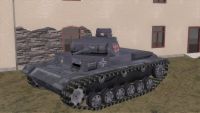
| |
| PzKw.IIIf |
PzKw.IIIf: German n00b issue tank. Can defeat the A13 rather easily, but not the Matilda or Char.B1-bis ... will also struggle from some angles against the other lighter French tanks, but from good approaches (side and rear) and short range will be capable of defeating them. Easily defeated itself because as with all German tanks of the 1940 period, armour was pretty lousy being thin and employing flat angles everywhere.
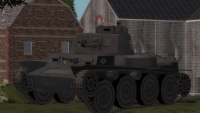
| |
| PzKw.38-T |
PzKw.38-T: This Czeck designed tank proved to have the best available German light tank gun after they captured the factory in 1940. The armour was pretty lousy and the mobility was not as good as their own Pz.III's but the extra penetration of the Czeck gun was a welcome addition to the German arsenal in the very early part of the war. It's still only a 37mm so it isn't going to do well against Matilda's and Char's. Like don't even try.
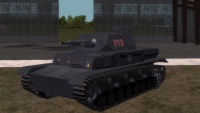
| |
| PzKw.IVd |
PzKw.IVd: The workhorse of the early period of the campaign in German WWIIOL. Thin armour (as usual for the Germans in this time frame) but a short 75mm gun that, once mastered (trajectory is tennis ballish) can defeat every tank it faces, although some (Matilda and Char. mainly) will still prove difficult and require experience to defeat. Having AP *and* HEAT (high explosive anti-tank) rounds gives it the punch that when used in ambush, will reward that tanker. HEAT vs Matilda and Char.B1-bis will work where the regular AP round might not.
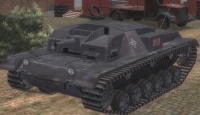
| |
| StuG.IIIb |
StuG.IIIb: For those that learn to master the StuG in combat, this begins the rewards the later long barreled III.g will bestow upon you in tier 3. The gun is the same as the PzKw.IVd so requires you understand how to use it's ammo choices and trajectory, but it's the "fixed gun you must pivot" nature of the StuG that demands experience to handle. Once you learn this and the range finder function; then the tier 3 version with the long barrel will allow you to become the ambush master at range. The StuG is also blessed with frontal armour that is nicely effective so it makes fighting at range a happier outcome for good tankers. Up close the need to pivot the tank means death to n00bish StuG tankers.
Tier 1
First "During Campaign" Introduction "Upgrade" Tier
French
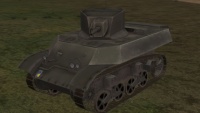
| |
| M3a5 Stuart |
M3a5 Stuart: in reality a light rather than medium tank, it makes up for it's lack of armour with hellacious speed and a good if somewhat small gun. It's only a 37mm but boasts the highest velocity obtained by anything in it's caliber for the length of the war, with the exception of squeeze-bore guns were are not modeled in WWIIOL. If used as a pure ambush "hit and run" tank this little wonder can do very well indeed.
British
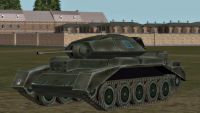
| |
| Crusader MK.2 |
Crusader MK.2: This version of this light cruiser platform, renamed the Crusader ... boasts nothing the earlier A-13 has with the exception of SLIGHTLY improved armour. The turret in particular gets much better sloping with the addition of spaced armour but in a world not populated by HEAT to any high degree, this upgrade really only has significant (and even then not greatly so) advantage in the following tier (tier 3 when RPAT infantry arrive) ... but it's a marginal and easily debated advantage at that. Since only the turret sides gain this attribute to any functional degree I could agree that it's an upgrade that really doesn't amount to much at all.
German
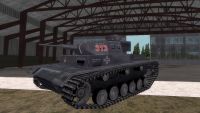
| |
| PzKw.IIIh |
PzKw.IIIh: A proper and linear (in the German tradition of the period) improvement or evolution of the design ... this tank can boast a much better gun in the KwK.38L42/50mm than the earlier 37mm doorknockers, and applique armour to the hull front giving it at least a modicum of survivability in frontal engagements. It's sides and rear are still dangerously thin however, with no real advantage over it's earlier version. Can take on the tier 0 Allied heavies (Matilda and Char.B1-bis) but you still want to try and get the drop on them ambush style if you can. Penetration is not going to be guaranteed under a lot of the available (and unsuccessful) angles of impact you may find your enemy offering you.
Tier 2
The 2nd "During Campaign" Introduction "Upgrade" Tier and Arguably the most Useful
French
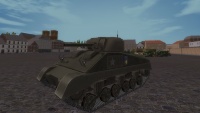
| |
| M4a2 Sherman |
M4a2 Sherman: Made available through the American lend-lease program, this becomes the standard "do everything" medium tank of the war on the Allied side. The gun while a 75mm "proper" caliber, is low velocity and it only succeeds against the German panzers through their employment of thin side and rear armour protection. Frontally since they have 80mm of armour, unless you are at short range, you're going to struggle. Their 75mm high velocity guns are better than yours. The HE round is useful against infantry and buildings, slightly more so than the German 75mm HE because it is a thin walled case traveling at a lower velocity, improving it's fusing to a small degree.
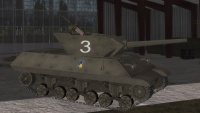
| |
| M10 Wolverine |
M10 Wolverine: The first attempt by the Americans (and lend leased to the French) to overcome the Shermans anti-tank weakness by offering much improved penetration, albeit in what would become known as the "tank destroyer concept". Lacking heavier armour, it was supposed to use speed to make up for it's lack of armour, but as things turned out this concept failed in many ways because it wasn't really any faster than a regular Sherman, and it's manually rotated turret was a huge deficit when compared to the Shermans fast motor drive turret traverse. The open turret top was also a disadvantage. The gun, an adaption of the 3" anti-aircraft gun of the period, was however a lot more effective versus armour (a lesson the Germans learned earlier with their very high velocity anti-aircraft guns employed versus armour) and it gains the functional use of range finding which, when used at long range, is a definite tactical advantage that the German players learned employing the mighty StuG assault gun AFV.
British
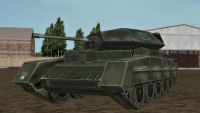
| |
| Crusader Mk.III |
Crusader Mk.III: staying within the British doctrine of lighter faster tanks, an early war approach that lingered longer than it should have ... the Crusader still has bugger all armour really, although again, it was made marginally thicker as a result of bitter anti-tank experience that revealed the fallacy of the British "lighter = faster = defendable" doctrine ... it still lagged behind what the bigger guns it was experiencing in combat showed was required. The employment of the hugely successful (for it's time) QF 6pdr. AT gun went some way to making the tank more effective than it's former versions however. Stay sharp, and relocate when under threat or after an ambush shot and you might do well.
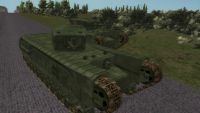
| |
| Churchill Mk.III |
Churchill Mk.III: finally the British are getting on board with what is fast becoming standard in terms of armour protection, none of this "thin but fast" stuff for the Churchill. Intended originally as an "infantry support" tank, it's armour is much more protective than anything except the Matilda before it, arguably designed for the same role although a bit of a misnomer ... having no high explosive capability. It is very slow, but it's an excellent tank for those who are patient and think ahead and plan their battles well. It's armour is not fantastic namely because the guns it faces are much better than during the Matilda's day ... but it is better than anything before it and can save you if you don't linger around EXPECTING it to save you.
The 57mm gun is the QF 6pdr. which while effective, needs to be closer to it's target than the 75mm guns of it's enemies, unless of course they are giving you their weak side or rear armour to shoot at.
German
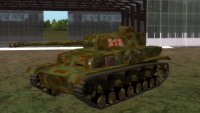
| |
| PzKw.IVg |
PzKw.IVg: A proper and linear (in the German tradition of the period) improvement or evolution of the earlier design ... this tank can boast a far better gun in the KwK.40L42/75mm than anything previous, and applique armour to the hull and turret front giving it at least a modicum of survivability in frontal engagements with 80mm on offer. It's sides and rear are still dangerously thin however, with no real advantage over it's earlier version. Can take on the any of Allied tanks, heavies included; but you still want to try and get the drop on them ambush style if you can. Penetration is far less of an issue now and if you can avoid frontal engagements, much easier to obtain quickly before your opponent can react to you. Ambushing is ALWAYS, in any tank, the best tactical approach to winning tank combat.
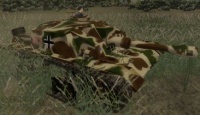
| |
| StuG.IIIg |
StuG.IIIg: This is the favourite of many experienced German tankers because, frontally at least; it's armour is very effective at stopping enemy shots from penetrating. There are two thin (50mm) side plates which are small but an obvious weakness if the enemy gets lucky. Stay at range and this is far less likely to happen. You have excellent range finding ability making first time shots feasible, and the truly excellent StuK.40L48/75mm gun, a slightly better gun than even the PzKw.IVg brings to the game. You have to learn some dedicated "StuG skills" in that the entire tank needs to be moved to traverse the gun, and you have no MG for anti-infantry protection ... but top players who have learned the StuG platform remain some of the highest scoring tankers in the game.
Tier 3
Last Existing Tier in the Game so far
British
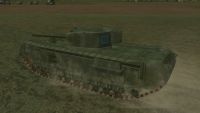
| |
| Churchill IV |
Churchill IV: Redefining "heavy armour" in a way that exceeds even the much vaunted Tiger tank in some areas, frontally it has 50% more armour than the Tiger, although this is the only area it beats the Tiger. This tank can take a pounding all day from almost any angle unless the enemy gets close to your sides or rear, even from an 88mm gun. Stupendously slow however, it requires patience and skill to employ well ... much as all British tanks do because, apart from the Matilda's obvious advantage in 1940's combat; British tanks were not exceedingly good overall compared to their contemporaries.
French
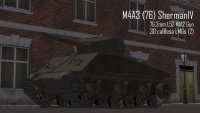
| |
| M4a3/76 Sherman |
M4a3/76 Sherman: The standard American Sherman approach was as we all know lacking due to a low velocity gun, and with the exception of well rounded (thus sloped) front hull armour and a thick turret mantlet *with* additional rotor shield (meaning frontally, only the turret outside the mantlet is weak from pure frontal impact) .... not the greatest in a game world with German high velocity 75 and 88 mm guns pointed at it.
To offset this to some degree, although still maintaining thin side and rear armour (it's real problem during the war) the Americans adapted the attributes of the M10 3" AA gun into a new 76mm higher velocity anti-tank gun. This gives the Sherman real punch on the battlefield and makes it the equal of the Mark.IV standard style of German panzer of the period, from any real attack or approach angle.
German
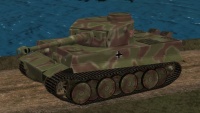
| |
| PzKw.VIe Tiger |
PzKw.VIe Tiger : The bad boy of tanks in the game, this tank is often overestimated by it's users when they first get one, because of attributes it could employ in the real war that are difficult to find in game. Namely, always engage at long range where your armour gives you great protection, and your 88mm gun will outperform their guns in all aspects except where range and armour exceeds performance, which means long range and from the front. In the game, ranges are almost always less than 500 or 600 yards (often 300 yards turns out to be common) and this is going to reveal that at such short range almost all the guns of the period, on any side, are going to hurt you, in any tank. Including a Tiger.
The Tiger is not slow, although the first 3 gears are kind of useless because terrain in game is not "sloppy" like it was in real life. If it is used sensible by a skilled player seeking to fire at ranges where the armour keeps him safe, he can become a battle changing participant fairly easily. The 88mm gun performs better at long range than anything the Allies have, and the frontal armour at 100mm (120mm on the turret face) will keep you in the fight until they manage to knock out your gun if they can hit it often enough. Because the Tiger is so survivable (to lots of impacts) it will reveal this game mechanic more often than other tank because usually, the shots that you are bouncing to get a dead gun have already penetrated those lesser tanks; and thus they never see a damaged gun. They are too busy being DEAD.
Tigers are hideously (for your enemy) effective when teamed up 2 or 3 together and firing at longer ranges where they can remain undamaged, yet killing the enemy as they try to approach the huge threat any such Tiger team has the potential to become. No other tank, even teamed up together, can approach the mile high local kill statistics a couple of Tigers can. With players resupplying them it is not unusual to see a pair or triplet of Tigers wipe out 5, 6 or even up to 10 times their number.
Having said that, they can also die in one hit if they find themselves in a bad situation. Despite what history might seem to say in documentary claims, they only have 80mm of armour everywhere but the front (which at 100mm isn't THAT amazing although it is very good) and the fact is, they did well historically by ambushing and then moving after killing several tanks, or by standing off at long range where the armour COULD do the job. Used that way in game they will succeed, drive up like Superman to within spitting range of the enemy, they will not. Tigers were ambush killed in real life and in game, they die this way at least as often.
When you die in a Tiger, remember, the PzKw.VIe in the game holds a 2:1 kill advantage over the closest Allied tank it faces (The M4a3/76 Sherman) and a 3:1 or greater advantage over everything else, if not as much as 6:1 for the lesser ones it sometimes eats alive.
Used properly, with skill, it is the biggest threat any other tanker can face.